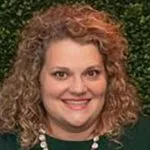Find out the circumstances that guided Dr. Ray Padilla from sports dentistry at the 1984 Olympic Games in Los Angeles to his roles as global lecturer, team dentist for the LA Lakers and trusted advisor to NCAA Division I players at UCLA. Then learn how a challenge from a colleague drew him to Australia and inspired him to educate on a large scale about injury prevention through properly-constructed athletic mouthguards.
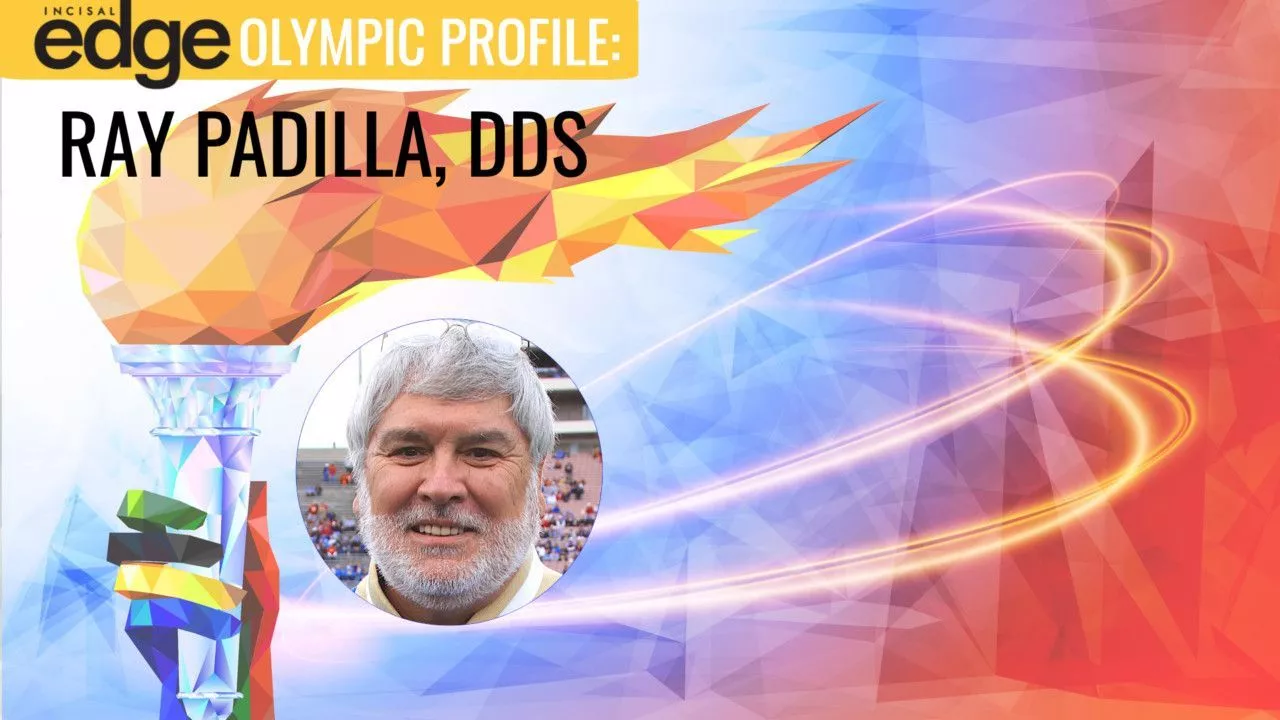
Dr. Ray Padilla dedicated his talents caring for patients in the Olympic Polyclinic during the 1984 Olympic Games. His involvement in Trauma Treatment and Sports Dentistry also includes 1994, 1999, and 2003 World Cup Soccer, 2004 IIHF World Hockey Championships in Prague, and 2015 Los Angeles Special Olympics World Games. He creates arguably the most effective protective gear for athletes on the West Coast, and beyond.
Patients at Dr. Ray Padilla’s Manhattan Beach dental practice receive the same standard of care as international Olympians, NBA headliners, and UCLA Bruins athletic teams. They may not realize that their family practitioner travels the globe as a lecturer, carries a microtorch in his dental bag and creates arguably the most effective protective gear for athletes on the West Coast, and beyond.
And while Dr. Padilla will gladly lead a dynamic discussion of why all mouthguards are not created equal, this preeminent expert and global lecturer on Sports Dentistry, Trauma Prevention and Treatment will never utter so much as a humble brag.
How did a young baller from Albuquerque come to be a team dentist for the LA Lakers and trusted advisor to NCAA Division I players? In Dr. Padilla’s life, if the interlocking circles of a Venn diagram were used to illustrate dentistry and sports, the overlapping commonalities would include dedication, success, Olympic games — and mouthguards.
“I’ve known since I was five years old that I wanted to be a dentist. I have no idea why. I didn’t go to the dentist very often when I was growing up. I really had no role model in dentistry…There was something inside of me…” he said.
As a high school athlete, his basketball team broke new ground.
“We were state champions for the first time in my high school my senior year. We had a very good basketball team, and we won the small school division. When you’re winning and winning and winning, you start to think you’re pretty good until you start playing some of the big boys,” he laughed.
After that championship season, he headed to then-California Western University, today U.S.I.U., to pursue an undergraduate degree in chemistry and biology and compete on the freshman basketball team. But, after one season playing college ball, his commitment to dentistry and a challenging double major won out.
Looking back, it seems like a fair trade: During dental school at the University of Southern California, he met a memorable dental hygienist.
“I wouldn’t have any patients if it weren’t for Margaret, the patients love her,” said Dr. Padilla, complimenting his wife of 42 years. Today he and Margaret share office space, and a love of sports, travel, and their two children, Jared and Jennifer.
At USC, he formed a true friendship with roommate Dr. Rick Lawson, whose persistence changed the course of Dr. Padilla’s career.
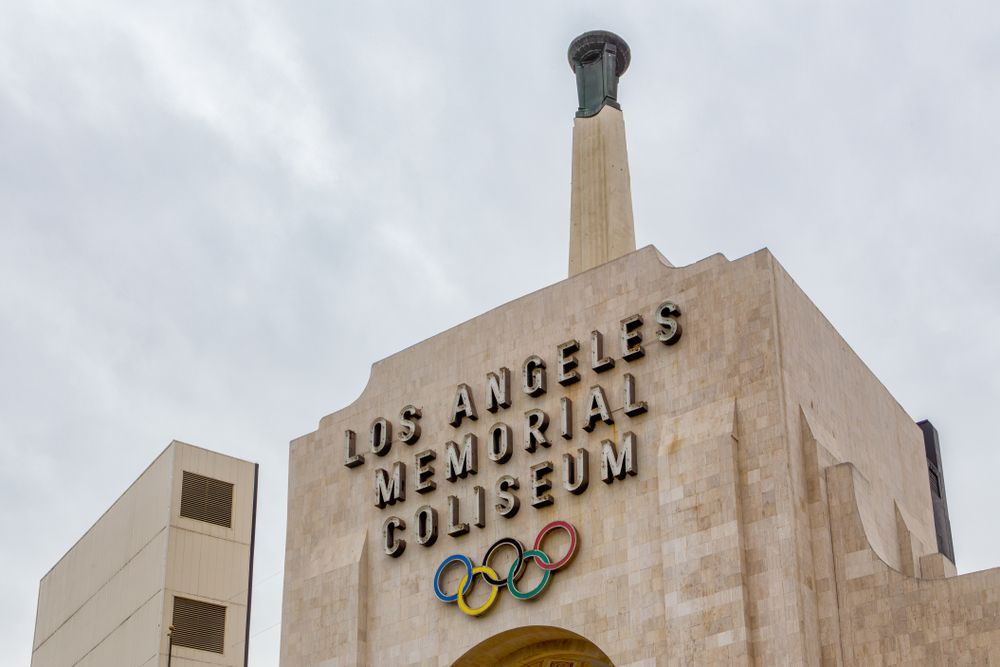
In a six-week span, during the 1984 Olympic Games in Los Angeles, a handful of dentists, including Dr. Ray Padilla, treated upwards of 100 patients per day, for a total of 2,000 visits to the dental clinic by athletes.
A a decision of Olympic proportions for Dr. Ray Padilla led to sports dentistry at the 1984 Olympic Games
In the summer of 1984, Los Angeles welcomed the Olympic Games for a second time (the first in 1932). American athletes preparing to compete included stalwarts such as Edwin Moses, ones-to-watch Carl Lewis, Gregory Louganis, and Mary-Lou Retton, and newcomers Michael Jordan, Chris Mullin and Patrick Ewing.
The young dentist, ever a sports enthusiast, planned to attend as spectator. Dr. Padilla reflects on how he nearly turned down an opportunity to provide treatment to world-class athletes.
“I had no idea that sports dentistry existed, even after I graduated. How I really got involved with it was my roommate in dental school Dr. Rick Lawson, from Arizona. He and Dr. Tom Kellen were organizers of the dental polyclinic at the 1984 Olympic games,“ he said.
“Dr. (Rick) Lawson called me to see if I wanted to be involved in the Olympic Polyclinic, and I said ‘No, I really don’t. I don’t want to be stuck in a dental clinic during the Olympic Games, I want to go to the events and watch the athletes.’ … I really didn’t want to do it. Finally, he talked me into it.” – Dr. Ray Padilla, on his first brush with sports dentistry during the 1984 Olympic Games in Los Angeles
In a six-week span, a handful of dentists, including Dr. Padilla, treated upwards of 100 patients per day, for a total of 2,000 visits to the dental clinic by athletes.
“From that point forward I just fell in love with sports dentistry… We treated some very influential athletes at the time, and I could see the effect we had on their play, the effect that we had on their results of the Olympic games…”
As he does today, Dr. Padilla dedicated identical efforts to every patient, regardless of station or status.
One marathon runner with considerable tooth decay was treated over the course of the month.
“The athlete was in pain and his life’s dream was to run the Olympic Marathon… He did finish, he was very, very proud. He was leaving the next day…and said, “Can you finish my dental work before I go back to my country?’ So, that evening we finished his dental work and got him out of his pain.”
“The dental polyclinic is even to this day one of the most used modality at the Olympic Polyclinic.”
Of note: During his 42-year career, Dr. Padilla has always been asked, never once applied, for these sought-after appointments.
This summer, one such invitation arrived from Dr. Paul Piccininni, Dental Director for International Olympic Committee (IOC) Medical Commission Group. He is responsible for organizing 20 years of dental polyclinics for the summer and winter Olympic games. Dr. Padilla’s charge: present a brief lecture on athletic mouthguards to dentists who will operate the Olympic Polyclinic in Japan during the Summer Olympic Games taking place with no spectators between July 23 and August 8, 2021.
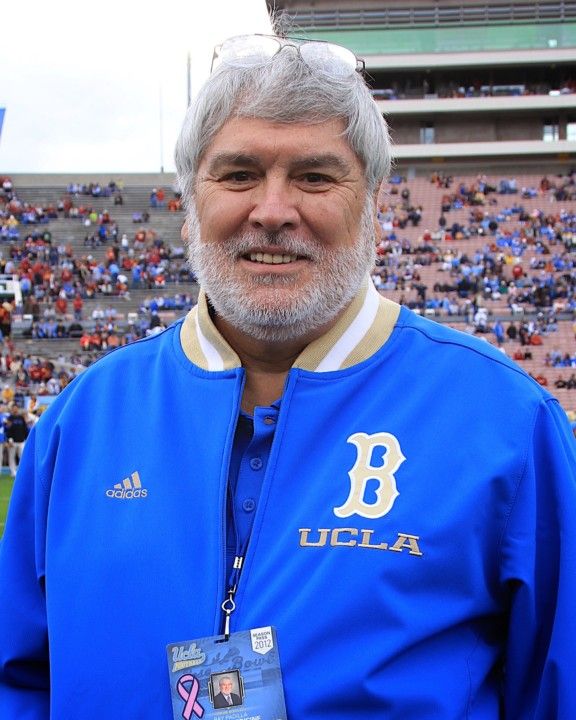
Ray Padilla, DDS, Team Dentist for UCLA Athletics, has been on faculty at the UCLA School of Dentistry for over 25 years, where he teaches in the AEGD Graduate Residency Program.
Mouthguards — How pressure led to progress
At UCLA’s AEGD department, a current sports dentistry lecture guides residents in making properly-fitted mouthguards using the pressure thermoforming technique, but 25 years ago vacuum fabricated thermoforming was the standard in the U.S. At that time, Dr. Padilla had learned the process from then-team dentist at University of Texas, Dr. Robert Morrow.
During the California Dental Association meeting in Anaheim, a lecture Dr. Padilla presented on the topic delivered surprising results – and more than a little pressure.
“I received a letter from a dentist – a review on my lecture – and he ripped me.” – Dr. Ray Padilla jokes about the inspiration from Dr. Brett Dorney that led him to the pressure thermoforming technique he uses to create custom mouthguards for athletes
“Dr. Brett Dorney stated, “If this (what you’re teaching) is the state-of-the-art mouth guard in the United States, then the United States is 10 years behind the times.’ My ego got involved and I responded, ‘Then show me what you’re doing.’ He did, and my mouth dropped. …He had been using pressure thermoforming in Australia for years and years. I hopped on an airplane and spent a week at his lab where he taught me the techniques. Then, along with others, I helped bring that technique back to the United States.”
Not everyone would rush into intercontinental travel in the name of progress, but Dr. Padilla, an innovator at heart, always embraces progress — and a challenge — with gusto.
In Australia, he was introduced to the Drufomat Pressure Thermoforming machine created in Unna Germany by Dr. Volker Dreve, and from there Dr. Padilla discovered a new calling: Educating on a large scale about the importance of injury prevention through properly constructed athletic mouthguards.
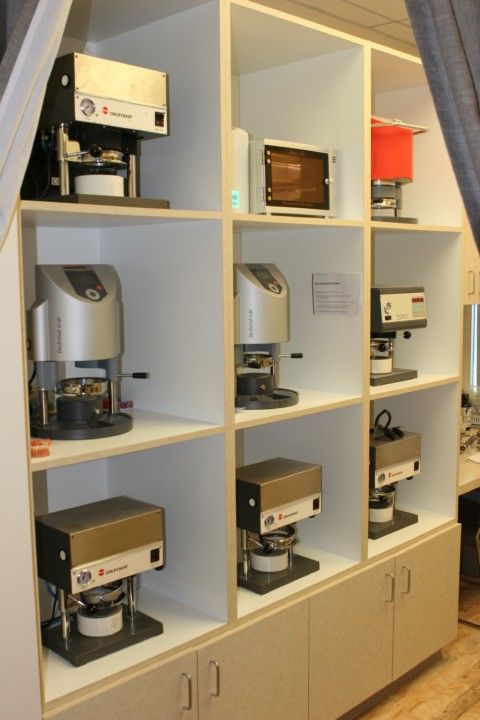
The dental lab of Dr. Ray Padilla in Manhattan Beach, California, with the Dreve Drufomat machine front and center. His office lab features eight machines to fabricate custom mouthguards.
How the Pressure Thermoforming process works
In pressure thermoforming, two or three layers of EVA material (an elastomer polymer with soft, flexible and rubber-like properties) are used to achieve the desired thickness required for the mouthguard. Layers become chemically-fused under a high heat and pressure during lamination.
“With vacuum-formed, you’re not going to get as accurate a fit. They tend to delaminate because you’re not using as much heat and as much pressure. … With injection molded mouthguards, you have to have a model, then you have to do a wax mouthguard … it’s a lot of work for that type of mouthguard and you don’t have uniform thickness, necessarily, because you don’t know how thick the wax is,” said Dr. Padilla, explaining pressure thermoforming’s edge over vacuum forming or injection.
“A lot of these mouthguards are not up to par — and I’m being kind when I say that. A lot of them are very, very poorly constructed, the impressions and accuracy are poor, etc.” – Dr. Ray Padilla, who creates arguably the most effective protective gear for athletes on the West Coast, and beyond.
Why does a well-constructed mouthguard matter so much?
“No matter who makes them, a mouthguard is only good if it’s worn. If they don’t like it, if they can’t talk, can’t breathe, they’re not going to wear it,” he said.
During his time playing college ball years ago, Dr. Padilla experienced the importance of mouthguards firsthand.
“We didn’t have a team dentist, so I wasn’t wearing a mouthguard. I did sustain a luxation injury. Right now, I have crowns on my front teeth and several root canals in my front teeth, from that dental injury playing sports.” – Dr. Ray Padilla, on firsthand experience with a mouth injury received during his college athletic career
“I want to make sure athletes wear them. I will do my best …use a different material rather than going to a lab where it’s one type of mouthguard and they send it to you in the mail.”
When speaking to athletes, he describes the benefits of the customization achieved through pressure thermoforming:
“What if you’re a high-profile athlete, you have a size 10 foot and you’re wearing a size 16 shoe. How well are you going to be able to compete wearing it? But if you have size 10 foot and you’re wearing a size 10 shoe, you’re going to be able to compete better.” — Dr. Ray Padilla describes the benefits of the mouthguard customization achieved through pressure thermoforming
He added, “If it fits, if it’s comfortable, if it’s protective, they’ll wear it. But if it’s uncomfortable, if it doesn’t fit properly, they’re not going to wear it.”
In his estimation, three factors determine how every mouthguard should be created: the sport that’s played, the level of competition and the athlete’s past history or trauma.
As for using the Dreve Drufomat Scan to prepare these customized creations:
“I’ve been using Dreve machines for well over 25-30 years. It’s my personal opinion that (Drufomat) is the best thermoforming machine in the world. Every one of my machines is a Dreve machine that I purchased 25 years ago that I’m still using. And, I have the new machines — scanning machines with all the bells and whistles. You have to have the right equipment,” said Dr. Padilla, referencing the eight machines in his office lab designed to fabricate custom mouthguards.
“… I threw my vacuum machine out at least 20 years ago. I didn’t want it; it wasn’t accurate enough in my opinion.” — Dr. Ray Padilla feels strongly about pressure thermoforming’s edge over vacuum forming or injection
For Dr. Padilla, the sheer volume of the mouthguards he creates warrants that number of machines. As an example, when he prepares for football season each August, Dr. Padilla makes about 200 mouthguards, for which he already has models.
“Creating them with one machine, one at a time, it takes about 30 to 40 minutes to make each one. That’s a lot of time. Now I can do eight at a time.”
How can dentists see ROI from Drufomat thermoforming machine
He offers a few thoughts on how any dentist can see a return on the investment, that will allow the machines (approximately $4,000 each) to eventually pay for themselves.
“I make other appliance in my office — all my night guards, occlusal guards, bleach trays, model duplication, denture repairs, orthodontic retainers. I do all of that with my machine. Yesterday I made two night guards and it cost me about $5 for both of them using one layer of Drufosoft® Pro material per mouthguard ($2.50 per sheet). I didn’t have to send the impression to a lab. I‘ve seen dental fees anywhere from $200 to $400 for a night guard, if not more.” — Dr. Ray Padilla explains how can dentists see ROI from Drufomat thermoforming machine
“If you come in today, I can have a night guard by the afternoon. I’m giving my patients more personalized care, a higher-quality care and I don’t have to use a laboratory. Also, I can easily teach my assistants.”
Make no mistake – there are no royalties, residuals or accolades driving Dr. Padilla’s pursuits, just the firm belief that all mouthpieces are not created equal, and that the most effective, most protective mouthpieces are those custom-made so that players will wear them.
“I’ve never had an injury with any player wearing a pressure thermoformed mouthguard and I’ve made 400-500 per year for the past 25 years.” — Dr. Ray Padilla, who creates arguably the most effective protective gear for athletes on the West Coast, and beyond.
Feedback from the athletes aligns.
“I’ve received many comments from athletes saying, ‘I didn’t think I could wear this. It’s very comfortable and protective. I don’t even know I’m wearing it,’ because they have that perception of the store bought boil-and-bite mouth guard. And … ‘Wow, this really fits, this is the best mouthguard I’ve ever had.’”
“I’ve had many athletes that left the schools that I’ve worked with, gone on to the professional level and requested I make mouthguards with the models I still have of them. I mail them to wherever they are living in different parts of the country with their professional teams.
Special personalization requests from athletes? Dr. Padilla’s golden.
“I’ve had one professional athlete ask if I can make all the teeth gold, and I did. My first layer was gold, I only added that to the tooth portion, then the second layer was clear. So, when he’s wearing the mouthguards it looks like all his teeth are gold.” —Dr. Ray Padilla on personalization requests for customized mouthguards he creates at his Manhattan Beach dental practice
He noted that some patients request a logo or their children’s names on the mouthguards, and he can easily accommodate any color or logo, provided they are not subject to copyright.
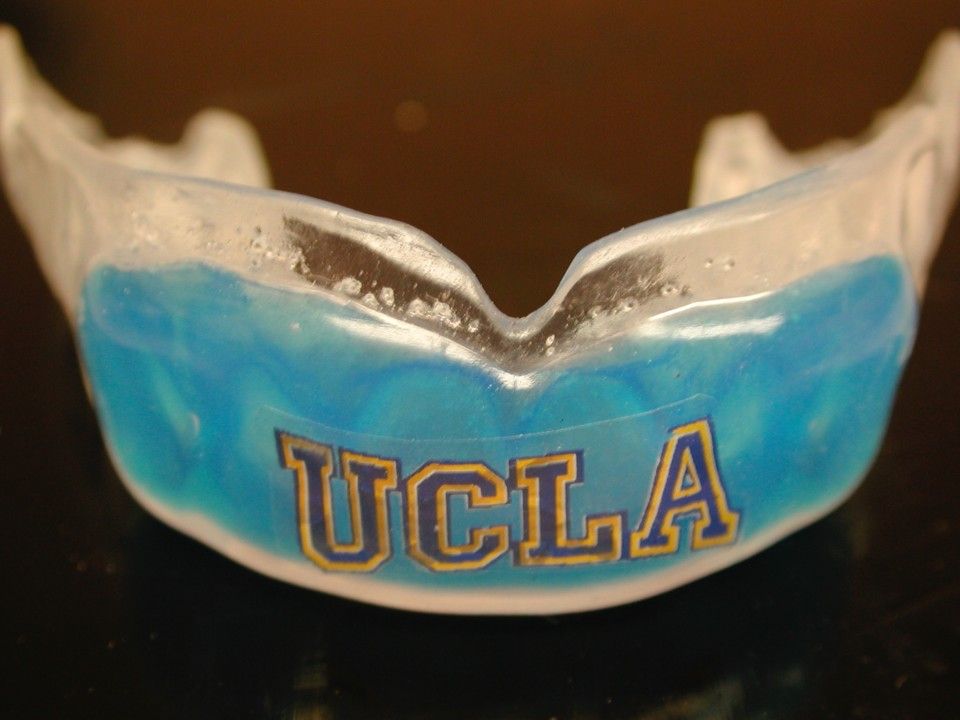
At UCLA, Team Dentist for UCLA Athletics, Dr. Ray Padilla creates over 400 mouthguards each year including 250 just for football, where every player begins the season with two mouthguards.
Sports Dentistry: How Can a Dentist Decide if It’s for Them?
A new dentist – or any dentist, for that matter, might not even recognize sports dentistry as an option, and Dr. Padilla offers three items for consideration:
- It’s not a recognized specialty, yet sports dentistry “encompasses almost every modality of dentistry.
You’re not only treating adults, you’re treating 8, 9, and 10-year-old children in mixed dentition. For luxations and evulsions, you’re using endodontics, and implant construction.” - Sports dentistry requires immediacy.
“Do we see very many dental injuries in sports? Not compared to other modalities, but when we’re needed, we’re needed immediately. Even though I’m not treating injuries every game I go to, when I am treating injuries, I am needed immediately, otherwise it’s not going to be successful treatment.”
He continued:
“In other modalities, for instance, you sprain your ACL in your knee. In the following days you’ll go get an MRI and they’ll determine extent of your injury and they’ll set you up for possible surgery or physical therapy. Dentistry is not like that. If you have a luxation injury, or an avulsion injury, that has to be treated immediately. You’re not talking about two hours later; you’re talking about 15 minutes later. When that injury happens, that tooth has to be placed back in, or the luxation has to be reduced back into the proper position, otherwise you’re not going to have a successful outcome.
- You’ve got to have credentials, background.
“When you’re asked to treat multimillion dollar athletes, you’d better have the knowledge and credentials to treat them, because you’ve got one chance to do it right.”
He explains his personal path to sports dentistry and offers suggestions to begin.
“I was team dentist at Bishop Amat (Memorial) High school in L. A. County for 17 years. There is where I saw injuries, I learned injuries, I worked with team physicians… I didn’t start out with pro teams. Just like any other profession …you need to put your time in, you don’t do it for the glory. You do it because you want to help people and you want to do it the correct way, so you’d better have a lot of experience.” — Dr. Ray Padilla
After weighing those insights, an interested dentist might not know where to begin.
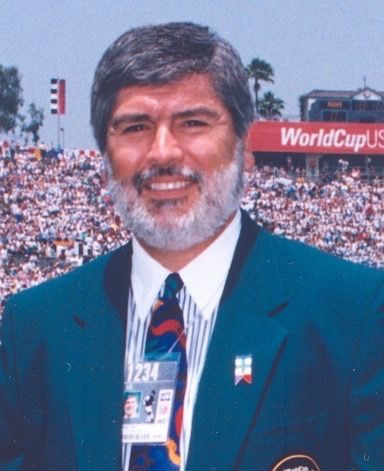
Dr. Ray Padilla’s involvement in Trauma Treatment and Sports Dentistry includes the 1994, 1999 and 2003 World Cup.
Sports Dentistry: How to Gain Experience and Education
Dr. Padilla suggests a few paths to gain professional experience and become further educated in sports dentistry.
- Join the Academy for Sports Dentistry.
“Unfortunately, it’s only a once-per-year symposium, but you’ll learn a lot in three days. They have a Team Dentist course, a Team Dentist certification, and after that you can attend two more days of either hands-on in suturing and athletic mouthguards or lectures on cosmetic dentistry.”
Padilla is charter member of the Academy for Sports Dentistry, the only organization in North America, and served as its President from 2010-2011. - Start at the level that needs you the most.
Ninety-five percent of high schools do not have team dentists, so that’s an ideal place to begin, said Dr. Padilla.
“Right now every NBA team has a team dentist, every NHL team has a team dentist. Which athletes do not have team dentists that need you the most? High schools… so start at a high school. When I started doing sports dentistry at Bishop Amat (Memorial) High School I wanted to give back to the community, plus I love sports.
An unexpected bonus: New patients and community that felt like family.
“Because I was the nice dentist who went to the high school and volunteered to give free mouthguards to the football team… all of a sudden I started getting an influx of new patients at my practice, and my practice grew through sports dentistry. I was pretty much the only dentist in my county doing sports dentistry at a high school level. I just wanted to give back to my community, be with the team and be among the athletes. I became one of them, part of their family…” — Dr. Ray Padilla, on how he gained experience at Bishop Amat Memorial High School and connected with the community
- Never stop learning.
A Fellow for the Academy for Sports Dentistry and the Pierre Fauchard Academy, Dr. Padilla began sharing his vast knowledge as an educator in 1989, lecturing nationally and abroad on cosmetic trauma treatment and injury prevention. Professional appointments, where he contributes presently, include his position for over 25 years on the faculty at UCLA School of Dentistry, where he teaches in the Advanced Education in General Dentistry Residency Program.He was appointed as Team Dentist for the Los Angeles Galaxy, Major League Soccer and UCLA Athletics in 1986 and Los Angeles Lakers in 2016, where he continues still today. He also served as Team Dentist for the Los Angeles Avengers Arena Football League from 2004 to 2009.
“Fortunately, because I’ve worked with so many teams at all levels – high school, college, professional, even amateur sports — I have had a lot of experience. A lot of that comes from my meetings with the Academy and my lecturing. I’ve learned so much lecturing, and from the questions that people ask me. I say ‘Wow, I’ve never thought of that!’ then do the research, look up papers. You learn because of that question that somebody asked you. At my age, I’m constantly learning new techniques and I’m learning from them also.”
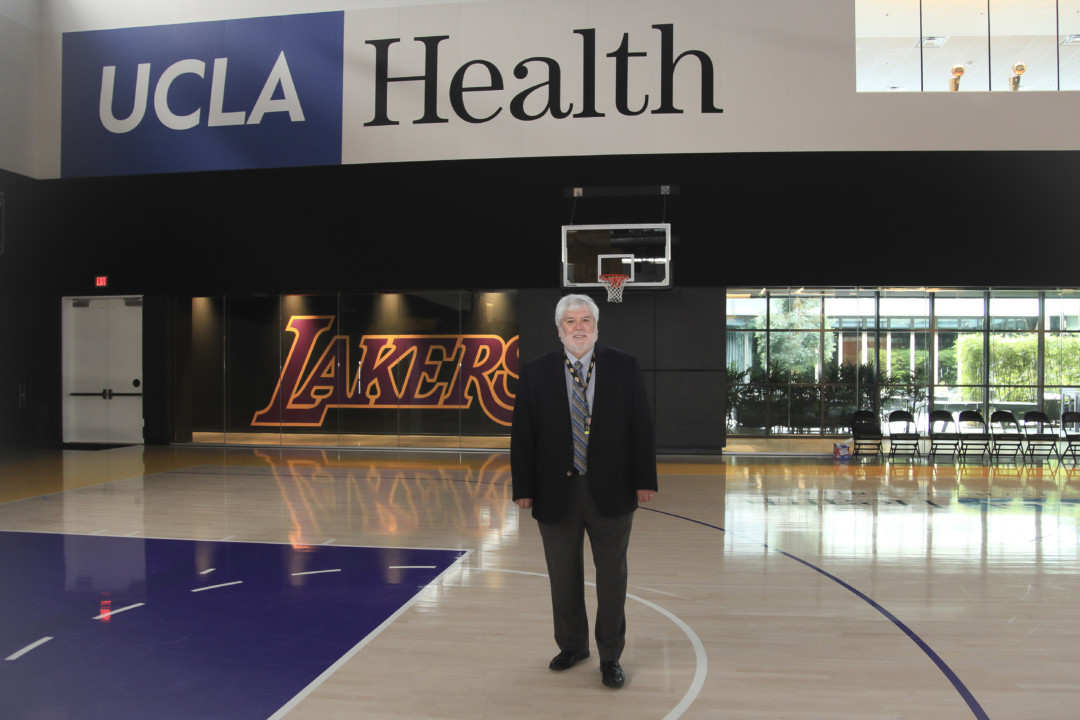
Ray Padilla, DDS, at the LA Lakers training center.
Why One Dentist Always Carries a Microtorch
From his first day in the field, Dr. Padilla never felt intimidated about the tasks at hand.
“Even coming out of dental school, I was confident from day one. I never was nervous, because I won’t put myself in a position unless I’m a 100 percent prepared… to this day I feel confident that I can at least make a diagnosis. If I can’t treat them, then I know where to refer them.”
One instrument Dr. Padilla carries in his dental bag confirms that exceptional level of preparation. To accommodate taking impressions by widening impression tray sizes for even the most sizeable of athletes and/or adjusting occlusion, Dr. Padilla keeps of all items, a microtorch, on hand.
“I have a little microtorch that I keep in my bag, while taking impressions on these large football or basketball players. I sometimes have to soften and widen the plastic trays that we use for impressions so they’ll fit. Sometimes the largest trays are too small.” – Dr. Ray Padilla, on what’s in his dental bag at all times
His ultimate goal: to encourage every athlete in his care to employ that same level of caution with their dentition to avoid unnecessary risk. How? By wearing a customized mouthpiece that provides protection from tooth loss and life- altering injuries.
“I think sports teach you a lot of other things about life. They teach you how to work with others, they teach you how to compete when you’re hurt, they teach you how to win, how to react when you lose. … Even if you’re not really athletic you should participate in sports because it teaches you a lot of good life lessons.”
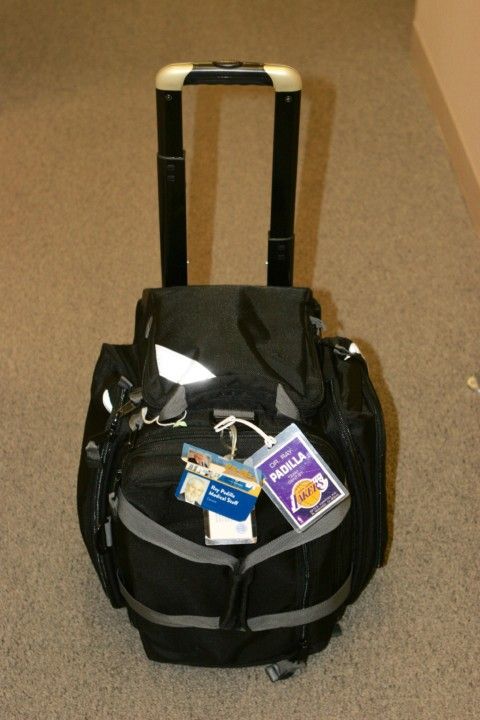
What’s in Dr. Ray Padilla’s dental bag at all times? “I have a little microtorch that I keep in my bag while taking impressions on these large football or basketball players. I sometimes have to soften and widen the plastic trays that we use for impressions so they’ll fit. Sometimes the largest trays are too small.”



